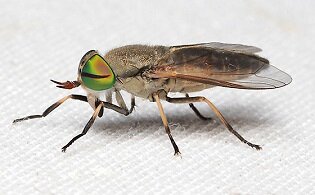Horse fly larvae
SCIENTIFIC NAME: Tabanidae
Number Of Species/Distribution
There are over 4,500 species in the tabanidae family.
These include the deer fly and the horse fly.
They are distributed throughout the world and are common in North America during the summer months.
Adult horse flies are more prevalent around aquatic habitats, as that is where they grow into adults.
Diet/Feeding
Tabanidae larvae are predators, collectors, and are even cannibalistic.
Mostly, the larvae eat small organisms such as insects, crustaceans, snails, earthworms, and other small invertebrates.
Tabanidae larvae will also eat other tabanidae larvae.
Although mostly predatory, deer flies also feed on organic debris from animals or plants that is deposited among the substrate.
The larvae have chewing or tearing mouthparts for feeding.
Adults feed mainly on plant nectar and other plant juices in order to obtain energy for flying.
Additionally, female adults require blood from mammals for reproduction.
The blood-sucking bites from the adult females can be very painful to mammals.
Habitat
Tabanidae larvae can commonly be found in ponds, marshes, and streams.
They can also be found in salt marshes, swamps, bogs, shallow lakes, and along the water's edge (a region called the 'riparian zone' of freshwater habitats.
They survive by burrowing down into the sand or gravel substrate of the water body they inhabit.
They can usually be found in areas where the water is slow-moving (called pools), although some species can be found in fast-flowing areas (called riffles).
HORSE FLY: INTERESTING FACTS
Horse fly bites can cause health problems to humans, such as severe lesions, high fever, and even disability.
Some people are allergic to the horse and deer flies' saliva, which they inject into the hosts' bodies in order to prevent blood clotting around the area being bitten.
Female horse flies usually bite during the day. They are attracted to mammals by movement, carbon dioxide (which mammals breathe out), warmth, and shiny surfaces.
Horse flies have beautiful eyes; they are often brightly coloured and sometimes have patterns and stripes.
The antennae of horse flies have five segments and are thick at the base, getting thinner at with each segment. Deer fly antennae are long and thin throughout.
The wings of horse flies are usually completely dark or completely clear. Conversely, deer fly wings are patterned.
Life Cycle
Tabanidae undergo complete metamorphosis, which involves passing through 4 complete life stages. These are the egg, the larvae, the pupa, and the adult stages.Egg
The egg mass laid by the female can contain anywhere from a few eggs to several hundred.
The mass is usually deposited on the vegetation that hangs over the water.
The eggs appear dark and shiny, and are shaped like spindles.
They hatch within five to twelve days, and the larvae drop into the water or moist soil.
Larvae
Once the larvae have dropped into the water after hatching, they burrow in the river substrate or the ground along the river bank, spending the winter in these burrows.
Sometimes the larvae take one to three years to complete the 6 to 13 stages of development (known as 'instars') that are typical in the Tabanidae life cycle.
In late spring, the larvae migrate towards dryer soils and progress into the next life stage, which is the pupal stage.
Pupae
The length of the pupal stage depends on the species and temperature, but may range from six to twelve days.
Adults
When Tabanidae adults emerge from their pupal stage they immediately begin mating and blood feeding.
Adults are great fliers, and search for their mates visually.
Most species of horse and deer flies have only one generation per year.
Sources
Field Guide to Texas Insects (1999). Irina Brake, The Diptera Site (2010). About the Tabanidae. Available here.
The Canadian Biodiversity Website (2010). Horse Flies and Deer Flies.University of Kentucky College of Agriculture, Department of Entomology (2010). Horse Flies and Deer Flies. Available here.
University of Minnesota; Guide to Aquatic Invertebrates of the Upper Midwest (2004). Diptera. Available here.
University of Rhode Island (1999). Deer and Horse Flies.BugGuide (2016). Tabanidae? Tabanus mularis. Available here.



